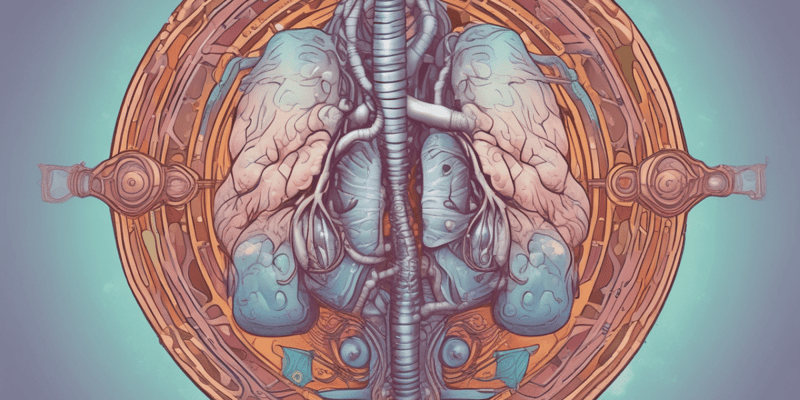Podcast Beta
Questions and Answers
Which of the following pathogens is commonly associated with community-acquired pneumonia?
Which of the following is NOT considered a risk factor for developing community-acquired pneumonia?
What clinical feature is most likely to be observed in a patient with community-acquired pneumonia?
Which diagnostic test is typically used to confirm the presence of infiltrates in cases of community-acquired pneumonia?
Signup and view all the answers
According to the CURB-65 criteria, which of the following indicates a potential need for hospitalization?
Signup and view all the answers
Study Notes
Definition
- Community-acquired pneumonia (CAP) is pneumonia acquired outside of healthcare settings.
Etiology
- Common pathogens include:
- Bacteria: Streptococcus pneumoniae, Haemophilus influenzae, Mycoplasma pneumoniae, Chlamydia pneumoniae
- Viruses: Influenza virus, Respiratory syncytial virus (RSV)
- Fungi: Histoplasma capsulatum (less common)
Risk Factors
- Age: Very young or elderly
- Cormorbidities: COPD, diabetes, heart disease
- Immunosuppression: HIV, cancer treatment
- Lifestyle: Smoking, alcohol use, poor nutrition
Clinical Features
- Symptoms:
- Cough (may be productive)
- Fever and chills
- Shortness of breath
- Chest pain (pleuritic)
- Signs:
- Tachypnea
- Dullness to percussion
- Bronchial breath sounds or crackles
Diagnosis
- Clinical assessment
- History and physical examination
- Radiology:
- Chest X-ray (presence of infiltrates)
- Laboratory tests:
- Sputum culture
- Blood cultures (in severe cases)
- Complete blood count (CBC)
Classification
- Mild, moderate, or severe based on:
- Vital signs
- Need for hospitalization
- Presence of comorbidities
- CURB-65 criteria:
- Confusion, urea>7 mmol/L, respiratory rate ≥30, blood pressure (systolic <90 or diastolic ≤60), age ≥65
Treatment
- Outpatient management for mild cases:
- Macrolides (e.g., azithromycin) or doxycycline
- Inpatient management for severe cases:
- Respiratory fluoroquinolones (e.g., levofloxacin) or a beta-lactam with macrolide
- Supportive care:
- Hydration, oxygen therapy if needed
Complications
- Pleural effusion
- Empyema
- Lung abscess
- Respiratory failure
- Sepsis
Prevention
- Vaccination:
- Pneumococcal vaccine
- Influenza vaccine
- Smoking cessation
- Good hygiene practices: Handwashing, avoiding close contact with sick individuals
Community-Acquired Pneumonia (CAP)
- CAP is pneumonia acquired outside of hospitals or healthcare facilities.
Causative Agents
- Bacteria commonly causing CAP include Streptococcus pneumoniae, Haemophilus influenzae, Mycoplasma pneumoniae, and Chlamydia pneumoniae.
- Viruses such as influenza and respiratory syncytial virus (RSV) are also frequent causes.
- Fungi, although less common, can also cause CAP, with Histoplasma capsulatum being an example.
Predisposing Factors
- Individuals at higher risk include the very young and the elderly.
- Pre-existing conditions like COPD, diabetes, and heart disease increase susceptibility.
- Weakened immune systems due to HIV or cancer treatments are significant risk factors.
- Lifestyle factors such as smoking, alcohol abuse, and poor nutrition contribute to the risk.
Clinical Presentation
- Typical symptoms encompass cough (often producing sputum), fever with chills, shortness of breath, and chest pain (often sharp and worsened by breathing).
- Physical examination may reveal rapid breathing (tachypnea), dullness on chest percussion, and abnormal breath sounds like crackles or bronchial breathing.
Diagnostic Approach
- Diagnosis begins with a thorough clinical evaluation including a detailed patient history and physical exam.
- Chest X-rays are crucial for visualizing lung infiltrates, confirming the presence of pneumonia.
- Laboratory tests, such as sputum culture for identifying the causative organism, blood cultures (especially in severe cases), and a complete blood count (CBC) help assess the infection's severity and guide treatment.
Severity Assessment
- CAP is classified into mild, moderate, or severe categories based on vital signs, the need for hospital admission, and the presence of underlying health problems.
- CURB-65 criteria are frequently used to stratify severity, considering confusion, blood urea levels, respiratory rate, blood pressure, and age ≥65.
Studying That Suits You
Use AI to generate personalized quizzes and flashcards to suit your learning preferences.
Description
This quiz covers key aspects of community-acquired pneumonia (CAP), including its definitions, etiology, risk factors, clinical features, and diagnostic methods. Test your knowledge on the common pathogens and symptoms associated with CAP. Understand how CAP can impact different age groups and those with underlying health conditions.




